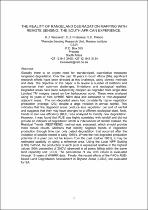 ResearchSpace
ResearchSpace
Reality of rangeland degradation mapping with remote sensing: the South African experience
JavaScript is disabled for your browser. Some features of this site may not work without it.
- ResearchSpace
- →
- Research Publications/Outputs
- →
- Conference Publications
- →
- View Item
| dc.contributor.author |
Wessels, Konrad J

|
|
| dc.contributor.author |
Pretorius, DJ

|
|
| dc.contributor.author |
Prince, SD

|
|
| dc.date.accessioned | 2009-03-27T13:51:34Z | |
| dc.date.available | 2009-03-27T13:51:34Z | |
| dc.date.issued | 2008-09 | |
| dc.identifier.citation | Wessels, KJ, Pretorius, DJ and Prince, SD. 2008. Reality of rangeland degradation mapping with remote sensing: the South African experience. 14th Australasian Remote Sensing and Photogrammetry Conference, Darwin, Australia, 29 September - 3 October 2008, pp 7 | en |
| dc.identifier.isbn | 9781921519154 | |
| dc.identifier.uri | http://hdl.handle.net/10204/3266 | |
| dc.description | 14th Australasian Remote Sensing and Photogrammetry Conference, Darwin, Australia, 29 September - 3 October 2008 | en |
| dc.description.abstract | Globally there is an urgent need for standardized, quantitative measures rangeland degradation. Over the past 10 years in South Africa (SA), significant research efforts have been directed at this challenge, using diverse methods and data. The objective of this paper is to review a number of methods and summarise their common challenges, limitations and ecological realities. Degraded areas have been subjectively mapped as degraded from single-date Landsat TM imagery based on low herbaceous cover. These were analysed using 16 years of 1km AVHRR NDVI data and compared to “non-degraded” adjacent areas. The non-degraded areas had consistently higher vegetation production (average 12%) despite a large variation in annual rainfall. This indicates that the degraded areas produce less vegetation per unit of rainfall and suggests that they may have changed to a different ecological state. Next, trends in rain use efficiency (RUE) was analysed to identify new degradation. However, it was found that RUE was highly correlated with rainfall and did not provide an indicator of degradation which is independent of rainfall. Instead, the Residual Trends (RESTREND) method was evaluated, which should provide more robust results. Methods that identify negative trends in vegetation production through time can only detect degradation that occurred after the inception of satellite record in early 1980’s | en |
| dc.language.iso | en | en |
| dc.subject | Remote sensing | en |
| dc.subject | Rangeland degradation | en |
| dc.subject | Vegetation production | en |
| dc.subject | Rainfall | en |
| dc.subject | 14th Australasian Remote Sensing and Photogrammetry Conference 2008 | en |
| dc.title | Reality of rangeland degradation mapping with remote sensing: the South African experience | en |
| dc.type | Conference Presentation | en |
| dc.identifier.apacitation | Wessels, K. J., Pretorius, D., & Prince, S. (2008). Reality of rangeland degradation mapping with remote sensing: the South African experience. http://hdl.handle.net/10204/3266 | en_ZA |
| dc.identifier.chicagocitation | Wessels, Konrad J, DJ Pretorius, and SD Prince. "Reality of rangeland degradation mapping with remote sensing: the South African experience." (2008): http://hdl.handle.net/10204/3266 | en_ZA |
| dc.identifier.vancouvercitation | Wessels KJ, Pretorius D, Prince S, Reality of rangeland degradation mapping with remote sensing: the South African experience; 2008. http://hdl.handle.net/10204/3266 . | en_ZA |
| dc.identifier.ris | TY - Conference Presentation AU - Wessels, Konrad J AU - Pretorius, DJ AU - Prince, SD AB - Globally there is an urgent need for standardized, quantitative measures rangeland degradation. Over the past 10 years in South Africa (SA), significant research efforts have been directed at this challenge, using diverse methods and data. The objective of this paper is to review a number of methods and summarise their common challenges, limitations and ecological realities. Degraded areas have been subjectively mapped as degraded from single-date Landsat TM imagery based on low herbaceous cover. These were analysed using 16 years of 1km AVHRR NDVI data and compared to “non-degraded” adjacent areas. The non-degraded areas had consistently higher vegetation production (average 12%) despite a large variation in annual rainfall. This indicates that the degraded areas produce less vegetation per unit of rainfall and suggests that they may have changed to a different ecological state. Next, trends in rain use efficiency (RUE) was analysed to identify new degradation. However, it was found that RUE was highly correlated with rainfall and did not provide an indicator of degradation which is independent of rainfall. Instead, the Residual Trends (RESTREND) method was evaluated, which should provide more robust results. Methods that identify negative trends in vegetation production through time can only detect degradation that occurred after the inception of satellite record in early 1980’s DA - 2008-09 DB - ResearchSpace DP - CSIR KW - Remote sensing KW - Rangeland degradation KW - Vegetation production KW - Rainfall KW - 14th Australasian Remote Sensing and Photogrammetry Conference 2008 LK - https://researchspace.csir.co.za PY - 2008 SM - 9781921519154 T1 - Reality of rangeland degradation mapping with remote sensing: the South African experience TI - Reality of rangeland degradation mapping with remote sensing: the South African experience UR - http://hdl.handle.net/10204/3266 ER - | en_ZA |





